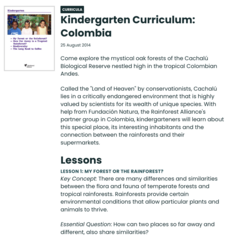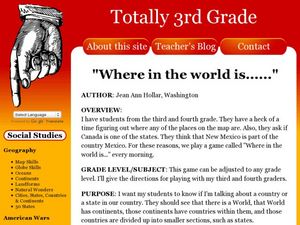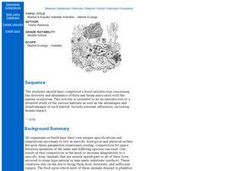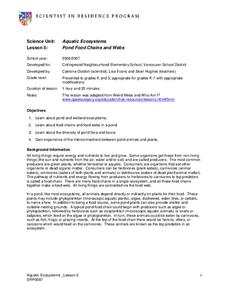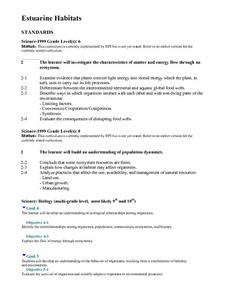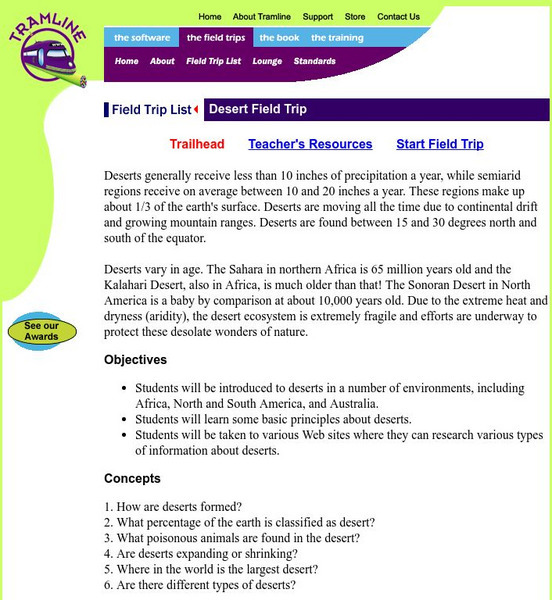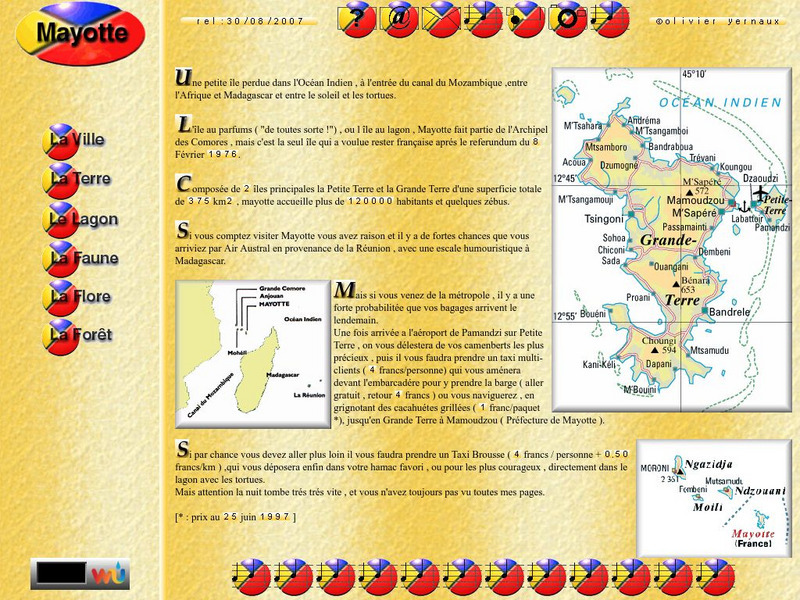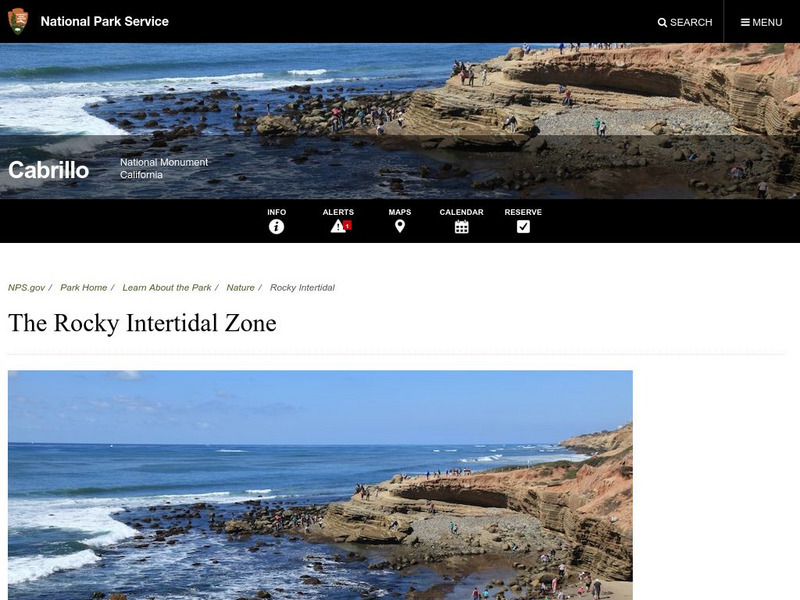Curated OER
My Forest or the Rainforest?
Students explore the flora and fauna of temperate forests and rainforests. They examine the environmental conditions that allow certain plants and animals to live in the rainforest.
Curated OER
Australian Mammals: Evolutionary Development as a Result of Geographic Isolation
Students comprehend the difference between monotremes, marsupials, and placental mammals. They are able to compare and contrast these organisms (Australian mammals) with other mammals. Students are able to identify Australian mammals.
Curated OER
Where in the World is...?
Young scholars work in groups to locate an appropriate planet where inhabitants of a fictional place can be relocated. They create a PowerPoint presentation to introduce their relocation site, as well as ecosystem information about the...
Curated OER
Cultural Murals
Seventh graders research the cultural time period of early Wisconsin people. They create a mural depicting the diet, shelter, activities, climate, clothing, tools, and other materials used.
Curated OER
Biomes and Ecosystems
Middle schoolers study biomes and ecosystems. They watch videos on rainforests and the food web and select a country of ancestry or interest to research. They write a report on the flora and fauna of their selected country. They...
Curated OER
Key Figures of the 1899 Harriman Alaska Expedition
Students gain general knowledge of the goals, route, participants, and significance of the 1899 Harriman Expedition. They link names of glaciers, fiords, mountains, flora and fauna with names of the 1899 Harriman Expedition...
Curated OER
Marine & Aquatic Habitats Activities - Marine Ecology
Middle schoolers enact the life cycle of a sessile animal and quantify the possibility of survival under the conditions given. They then present to the class a new adaptation which will increase the animals chance of survival.
Curated OER
Aquatic Ecosystems
Students study ponds and wetland ecosystems and examine the food chains and webs in them. In this aquatic ecosystems lesson students answer questions about the diversity of the flora and fauna in a pond.
Curated OER
Estuarine Habitats
Sixth graders study the important habitats, flora, fauna, and physical factors of coastal habitats. They compare the aquatic habitats to terrestrial habitats by researching and completing tables with the information.
PBS
Pbs Learning Media: Deep Sea Bestiary
This document from NOVA: "Into the Abyss" describes the physical and behavioral traits of some of the least-known and most unlikely creatures on Earth.
Tramline
A Desert Virtual Field Trip
Travel with your students on a virtual field trip and explore the deserts of the world! This is site is interactive and informative.
Science Education Resource Center at Carleton College
Serc: Investigating the Stories of the Land
In this biology field investigation, learners will use observation skills to describe different types of terrestrial landscapes and compare them with one another. They will utilize these data in order to begin to put together the stories...
Other
Glin: Endangered Species Network
Links to the Gulf Point, endangered species and habitats, and Great Lakes declining amphibians. There are links to events, laws, species and related resources.
Other
Mayotte
A beautiful map with links to information on Mayotte's fauna and flora, cities, lagoon and forests.
Other
Kamat.com: Animals of Indian Mythology
First published in The Quarterly Journal of the Mythic Society, this article discusses animals and their meanings in Indian mythology. Part of an extensive Indian culture site.
Other
Pella Museum: Paleontology and Geology of Jordan
This English language site focuses on the paleontology, geology, and the fossilized flora, and fauna Jordan. Scientific articles are interspersed with extensive photographs and descriptions of various features.
Smithsonian Institution
National Museum of Natural History: Paleobiology: The Cambrian Period
Journey into the past while reading this comprehensive overview of the Cambrian Period that covers topics such as the Cambrian Explosion, Burgess Shale fauna, trilobites, fossil evidence, and climate and plate tectonics.
Smithsonian Institution
National Museum of Natural History: Paleobiology: The Proterozoic Eon
Journey into the past while reading this comprehensive overview of the Proterozoic Eon that covers topics such as the Prokaryotic life, Eukaryotes, glaciation, fauna evidence, and multicellular life forms.
Curated OER
National Park Service: Cabrillo Natl Monument/tide Pools Windows to the Sea
National Park Service page about the plight of the owl limpet, a small fish resident of Southern Californian tide pools
DOGO Media
Dogo News: Week of 4 25 16: Stunning Images of Our Beautiful Planet
Beautiful photos of our planet in celebration of Earth Day. Includes video.
Other
Perth Zoo
Describes the Perth Zoo, and gives information about its current exhibits and events. Also provides education links to learn about wildlife and wildlife preservation.
Other
Friends of Neal Smith National Wildlife Refuge: Homepage
You can visit the tall grasses on Iowa. There is 7,000 acres on this refuge. You can see elk and buffalo. You can go on an auto tour, or go hiking on a trail.
Other
Galapagos Islands: Wildlife Gallery
Great photos and descriptions of the wildlife in the Galapagos Islands. There are also links to information on the natural history, environment, and geology of these islands.
Museum of Science
Museum of Science: Looking at the Sea
There are 5 parts to this resource. You can click on the water planet, oceans in motion, life in the sea, scientists at sea and resources. There are also activities for teachers.


